Dispatch from Jerusalem
By Charles Rush
March 9, 2008
John 11: 1-27
[ Audio
(mp3, 13Mb)
]
just returned from an incredibly rich 8 days in Israel and the West Bank meeting with leaders from the Israeli government, the army, representatives from the PLO, Arab Christians… all the while rockets were flying overhead and the Arabs shut down all their shops to protest the Israeli invasion of Gaza that left 126 people dead, some of them children. I happened to be walking alone through East Jerusalem in the Christian and Muslim quarter when the Arabs were shutting down their shops. This bustling, ancient souk, streets just slightly wider than a truck, suddenly all locked up, almost completely deserted and I'm the only European. The TV is filled with Arabs seething with anger, vowing revenge, all of them collectively in grief, rapidly forming solidarity around the poisonous brotherhood of frustration and helpless victimhood. The air has a palpable fear unto dread that something very, very bad could happen at any moment. These are the burned over social fields which are necessary before the seed of martyrdom will drop and germinate into its pernicious still born fury.
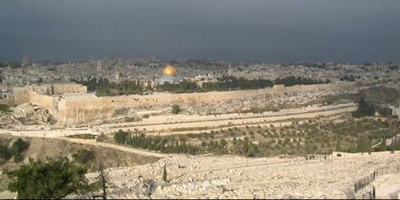 I stood down in
the Kidron valley [slide_01]
looking up at the ancient walls of Jerusalem, standing in pretty much the same
place that Jesus stood when he prayed for Jerusalem 2000 years ago, standing in
pretty much the same spot that David stood 3000 years ago when he decided to
establish a wee capital city in his wee kingdom. The word Jerusalem literally means ‘The foundation of
peace' and yet it is, and has been so full of violence. And there is no
question that as a Christian, especially as a Christian Minister and Academic,
it is sobering to reflect on the fact that this one square kilometer of
spiritual real estate has been fought so many times in the name of religion,
that even today you can fairly well compress the multifarious tensions of our
world into the ones that reside on the Temple Mount.
I stood down in
the Kidron valley [slide_01]
looking up at the ancient walls of Jerusalem, standing in pretty much the same
place that Jesus stood when he prayed for Jerusalem 2000 years ago, standing in
pretty much the same spot that David stood 3000 years ago when he decided to
establish a wee capital city in his wee kingdom. The word Jerusalem literally means ‘The foundation of
peace' and yet it is, and has been so full of violence. And there is no
question that as a Christian, especially as a Christian Minister and Academic,
it is sobering to reflect on the fact that this one square kilometer of
spiritual real estate has been fought so many times in the name of religion,
that even today you can fairly well compress the multifarious tensions of our
world into the ones that reside on the Temple Mount.
Despite the
violence, despite the guys hawking rosary beads outside every site that
pilgrims visit, Jerusalem
is a place that is spiritually thick. Personally, it was very moving for me to
be there. I prayed at the Wall when I was 19 and to stand there again at 50. It
is just very moving and complex.
I thought I
might explain to you just why this place is so problematic and why religion is
such a source of conflict. It is hard for Americans to get a feel for this
because we have a tendency to project what we mean by religion onto other
people and presume that, more or less, we are talking about the same thing. But
we are not. And it is important to at least to have some rudimentary
appreciation of these realities because-whether we like it or not- this is
going to become pivotal for our whole world for the next several decades.
What is the
religious significance of this city? And why can't these three faiths- Judaism,
Christianity, and Islam- all just get along? Don't they worship the same God?
Some history
simply has to be explained here but you will probably find this more than
slightly interesting. 3700 years ago, a man named Abraham, born in what is
today Iraq,
heard God speak to him in a dream that God would bestow upon him a promise of
land and a future of people. But he was elderly and had no children. How could
this be?
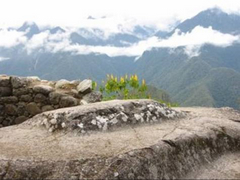 Eventually, his
wife Sara has a son Isaac, but not before Abraham complicates the story by
having another son Ishmael with a slave woman Hagar. As one Arab remarked to me
this week, in the middle of the conflict, ‘we are here today because one man
tried to solve his problems by taking two women.' But I cannot digress. Abraham
moves to what is today the West Bank and when his son Isaac is a teenager,
Abraham again hears God telling him to take this son, this precious son through
whom this people will be born, and to take him up to Mt. Moriah.
[slide_02] That is
where Jerusalem
is today. He gets up to the top of the mountain which is full of craggy rocks
and olive trees and there is an outcropping of stone there that is kind of a
natural altar.
Eventually, his
wife Sara has a son Isaac, but not before Abraham complicates the story by
having another son Ishmael with a slave woman Hagar. As one Arab remarked to me
this week, in the middle of the conflict, ‘we are here today because one man
tried to solve his problems by taking two women.' But I cannot digress. Abraham
moves to what is today the West Bank and when his son Isaac is a teenager,
Abraham again hears God telling him to take this son, this precious son through
whom this people will be born, and to take him up to Mt. Moriah.
[slide_02] That is
where Jerusalem
is today. He gets up to the top of the mountain which is full of craggy rocks
and olive trees and there is an outcropping of stone there that is kind of a
natural altar.
The story itself
if probably significant religiously because the story is told in a way that God
wants to test Abraham's commitment to God. How devoted is Abraham? If he had to
choose between his only son… the bible actually uses a three fold repetition to
make the point. It says, ‘his son, his only son, the son whom he loved'… If he
had to choose between his only son and God, which would he choose? Is he that
devoted to God?
He chooses God
and in the process, God saves his son too. I think it is probably very
significant that this one story is the Ur Story, the story of origin for all
three Abrahamic religions- Judaism, Christianity, and Islam- because it is a
story that juxtaposes ‘trusting faith' in some significant ways with the
‘reasonable bonds' that tie us to family. There is a dramatic tension in the
text because God is asking Abraham to sacrifice his son. God is asking Abraham
to do something immoral as an expression of his obedient devotion. At a minimum
it seems to place obedient devotion above even normal ethical constraints, at
least on the surface. Certainly this text has fostered a certain spiritual
disposition in all three traditions that have elevated faithful obedience in
dangerous ways. Or maybe we could say that extremists in every age find partial
justification for their fanatical devotion by referencing texts like this
whatever their subtle meaning actually was originally.
 But this story
got handed down, handed down again. The descendants of Abraham, Isaac, Jacob,
and Esau eventually grew numerous, get enslaved in Egypt,
come out of Egypt
with Moses, settle again near this place. [slide_03] And one day, around 1000 b.c. they
actually control enough of the area that you could say they were a small nation
with a king, named David. He decides to build a capital and he chooses the
place where Abraham nearly sacrificed Isaac. Right below that spot, he starts
to build a city. He dies.
But this story
got handed down, handed down again. The descendants of Abraham, Isaac, Jacob,
and Esau eventually grew numerous, get enslaved in Egypt,
come out of Egypt
with Moses, settle again near this place. [slide_03] And one day, around 1000 b.c. they
actually control enough of the area that you could say they were a small nation
with a king, named David. He decides to build a capital and he chooses the
place where Abraham nearly sacrificed Isaac. Right below that spot, he starts
to build a city. He dies.
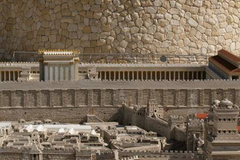 His son,
Solomon, becomes the king. He decides that the people need a Temple
to worship, [slide_04]
a central Temple that people can come to from
all around, so he builds this Temple
right over the rock that Abraham used to nearly sacrifice Isaac. Indeed, this Temple has two buildings-
really a building within a building. The inner building is called the “Holy of
the Holies”, where the priests alone enter and pray and inside this area is
this big stone.
His son,
Solomon, becomes the king. He decides that the people need a Temple
to worship, [slide_04]
a central Temple that people can come to from
all around, so he builds this Temple
right over the rock that Abraham used to nearly sacrifice Isaac. Indeed, this Temple has two buildings-
really a building within a building. The inner building is called the “Holy of
the Holies”, where the priests alone enter and pray and inside this area is
this big stone.
500 years later,
Jerusalem is utterly destroyed by people that
live in what is today Iran.
Everyone, literally everyone, is sent to exile as slaves, most of them living
in what is today Teheran. Couple hundred years go by, the Persian
empire degrades and a bunch of these exiled Jews move back.
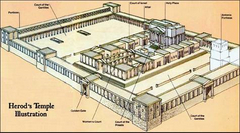 A couple hundred
years after that Rome conquers the whole
Mediteranean and the local King of the region, Herod, [slide_05] offers to rebuild the Temple at Jerusalem
following the tradition of the Romans who sought to give local people as much
of their culture and religion so as to develop good will and prevent constant
rebellion. He builds a much bigger area, including, so Roman, a military
outpost right on one side and the governmental buildings on the other. That is
the way that it was at the time of Jesus and part of those walls are still the
standing today. I might add, simply very impressive work.
A couple hundred
years after that Rome conquers the whole
Mediteranean and the local King of the region, Herod, [slide_05] offers to rebuild the Temple at Jerusalem
following the tradition of the Romans who sought to give local people as much
of their culture and religion so as to develop good will and prevent constant
rebellion. He builds a much bigger area, including, so Roman, a military
outpost right on one side and the governmental buildings on the other. That is
the way that it was at the time of Jesus and part of those walls are still the
standing today. I might add, simply very impressive work.
About 30 years
after Jesus died, the Jews revolted against the Romans but the revolt didn't
last long. The Romans sent in massive troops, absolutely smashed the rebellion
as was the Roman way, ripped down the Temple
they had built and most of the other buildings in Jerusalem. Then they rounded up the people of
the area, enslave a great group of them, and drove the rest into either what is
today Turkey or Spain, both
Roman outposts. This is what Jews call the Diaspora. They were dispersed to the
ends of the empire.
The Roman Empire
started to fall apart over the next few centuries and Jerusalem was just empty
for almost 600 years, except for many groups of Christians who started coming
there from all over the Roman empire right after the time of Jesus. Pilgrims
would come to the area and the Christians developed monasteries in the places
where Jesus was born, the places where Jesus grew up, the places Jesus went
that are mentioned in the bible. Of course, all of the places in Jerusalem itself where
Jesus went during Holy Week, the week that he died. During this period, a few
Jews moved back. But it was largely Arab Christians, Christians from
practically every nation in Europe who were
Monks in little communities here and there. The Dark Ages were descending.
In the 7th
Century, Arabs started following the prophet Mohammed and they fanned out from
what is today Saudi Arabia
and either converted or conquered land after land in the Middle
East. Jerusalem
is not actually mentioned in the Koran, apart from the fact that it was a well
known capital in the ancient world. But there is a Hadith that says that
Mohammed ascended into heaven from- and this is critical- from the very rock on
which Abraham nearly sacrificed Isaac, the very rock that was in the Holy of
Holies in the Temple.
Hadith is the earliest body of Islamic scholarship that interprets the Koran.
It is like the Talmud is to Judaism. It carries a lot of authority.
So the Arabs
decided to conquer Jerusalem
and they did. Entering the Temple
Mount area, they found
the stone exposed. Naturally, they decided to put a Mosque over it. And, more
or less, it has been standing there ever since.
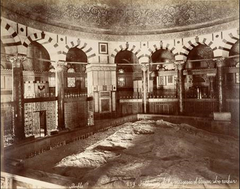 I say, more or
less, because the Christians tried to re-conquer this area. They held it for a
while, lost it, held it, lost it- Crusdaers that, trust me, didn't look a thing
like Orlando Bloom, Liam Neeson, or Sean Connery. [slide_06]
I say, more or
less, because the Christians tried to re-conquer this area. They held it for a
while, lost it, held it, lost it- Crusdaers that, trust me, didn't look a thing
like Orlando Bloom, Liam Neeson, or Sean Connery. [slide_06]
But, long story
short- the last thousand years- Muslims and Christians and now Jews again-
we've been fighting over a rock. Let me correct myself, a sacred hunk of rock… but it is a
rock. Obviously, the labyrinthine motivations and the Byzantine justification
for why these complex groups do what they do is much more complicated if you
want to understand all of the nuance. But at the end of the day, all of the
sacred sites in the Walled city of Jerusalem comprise 1
square kilometer, with one single rock in the middle of it.
I could say a
lot more but I won't. I just want you to know this broad history. If you don't,
you should!
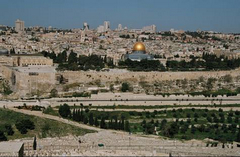
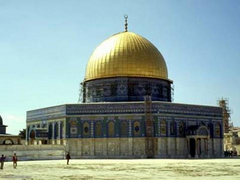 [slide_07] Now, you will
ask the obvious American question, ‘Why can't they just share?' ‘Why can't we
all just get along?' Or if we were to put it in terms of the language of
international diplomacy, ‘Why don't we just make the Old City of Jerusalem and
international City, supervised by representatives from the UN with
participation of the religious leaders of [slide_08] each of the major faiths, so that each
of the Holy Sites is respected by each other, and everyone can use this as a
place for worship in dignity?' Western Jerusalem, outside the old walled city,
could then be the capital of Israel
and Eastern Jerusalem, named Al Quds by the Arabs, outside the old walled city,
could become the capital of Palestine.
It could happen. It is a reasonable solution.
[slide_07] Now, you will
ask the obvious American question, ‘Why can't they just share?' ‘Why can't we
all just get along?' Or if we were to put it in terms of the language of
international diplomacy, ‘Why don't we just make the Old City of Jerusalem and
international City, supervised by representatives from the UN with
participation of the religious leaders of [slide_08] each of the major faiths, so that each
of the Holy Sites is respected by each other, and everyone can use this as a
place for worship in dignity?' Western Jerusalem, outside the old walled city,
could then be the capital of Israel
and Eastern Jerusalem, named Al Quds by the Arabs, outside the old walled city,
could become the capital of Palestine.
It could happen. It is a reasonable solution.
But, this is
also where the moral of our
story comes back again. It favors ‘rather uncritical-unqualified complete
obedience' to God over ‘reasonable' compromises that we make to meet the needs
of many different people.
We don't
understand this in America
because of our unique history. Last week I heard the same comment from Orthodox
Jews, Orthodox Muslims, and Christian Arabs that makes this point. Each one of
them said that they were jealous of us Americans. They aren't jealous of our
wealth, although they are too. They aren't jealous of our power, although they
are too. They are jealous… that we don't drag behind us this thousand years of
feudal history that they cannot completely transcend. We Americans just bounce
along like every complex problem can be resolved if we can just figure out how
to appeal to everyone's enlightened self-interest and develop a creative
compromise. We don't get it.
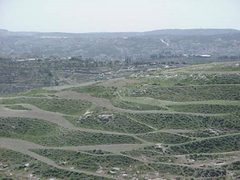 I was standing
in Bethlehem
with a couple of Americans and our Christian Arab speaker, making small talk.
One of the Americans asks him how long his family has lived in Bethlehem. [slide_09] We Americans say, “Oh, we've lived in Summit for 20 years now.”
Our Arab speaker says, ‘Well, my family sold this field in 1750 but we actually
lived here until until the 2nd World War. And my clan has lived here
for 2000 years.”
I was standing
in Bethlehem
with a couple of Americans and our Christian Arab speaker, making small talk.
One of the Americans asks him how long his family has lived in Bethlehem. [slide_09] We Americans say, “Oh, we've lived in Summit for 20 years now.”
Our Arab speaker says, ‘Well, my family sold this field in 1750 but we actually
lived here until until the 2nd World War. And my clan has lived here
for 2000 years.”
 I was amused by
this so I said, ‘so who did your family support when Saladin invaded?' [slide_10] Saladin was a
Muslim, the Sultan of Egypt, around 1180 when he conquered Jerusalem in the name of Allah that provoked
the 3rd Crusade. Without missing a beat, he said, “Saladin… and most
Western Christians find that surprising.” Now, in America, if you can trace your
family back 200 years, that is a big deal. And I doubt you've ever heard of
Saladin or know anything about him at all. This guy can tell you what his
family was doing…. 900 years ago. We simply do not have baggage like that to
drag around and we certainly don't have an identity that is rooted in place and
culture to go with it.
I was amused by
this so I said, ‘so who did your family support when Saladin invaded?' [slide_10] Saladin was a
Muslim, the Sultan of Egypt, around 1180 when he conquered Jerusalem in the name of Allah that provoked
the 3rd Crusade. Without missing a beat, he said, “Saladin… and most
Western Christians find that surprising.” Now, in America, if you can trace your
family back 200 years, that is a big deal. And I doubt you've ever heard of
Saladin or know anything about him at all. This guy can tell you what his
family was doing…. 900 years ago. We simply do not have baggage like that to
drag around and we certainly don't have an identity that is rooted in place and
culture to go with it.
Which brings me
to religion… We have a tendency, naturally, to think that religion here
functions like religion there, only a little differently, maybe a little older,
but pretty much the same. You would be wrong.

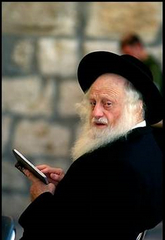 The first thing that strikes you in
the Middle East is how religion functions in society [slide_11] and here I would like to take
the ultra-Orthodox Jewish community simply because we see these people in our
area. More and more of them have moved to Israel and they tend to take over
whole neighborhoods much like they do here so that they can keep their religion
without having to make compromises with their non-Orthodox neighbors. [slide_12]
The first thing that strikes you in
the Middle East is how religion functions in society [slide_11] and here I would like to take
the ultra-Orthodox Jewish community simply because we see these people in our
area. More and more of them have moved to Israel and they tend to take over
whole neighborhoods much like they do here so that they can keep their religion
without having to make compromises with their non-Orthodox neighbors. [slide_12]
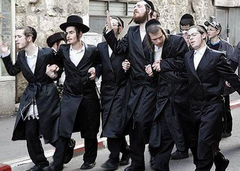 They dress in clothes that are rooted
in a fashion from a couple hundred years ago. That is because their religious
orientation looks backward towards an age when things were purer than they are
today. And they believe that one of our primary tasks in this life is to
develop such purity as we can in our personal life and in our communal life. [slide_13] In order to
achieve that, they not only live in communities of tight proximity that create,
so to speak, a hedge around them. And they also engage in a pretty
comprehensive study- of course, overwhelmingnly oriented to men, who are the
leaders.
They dress in clothes that are rooted
in a fashion from a couple hundred years ago. That is because their religious
orientation looks backward towards an age when things were purer than they are
today. And they believe that one of our primary tasks in this life is to
develop such purity as we can in our personal life and in our communal life. [slide_13] In order to
achieve that, they not only live in communities of tight proximity that create,
so to speak, a hedge around them. And they also engage in a pretty
comprehensive study- of course, overwhelmingnly oriented to men, who are the
leaders.
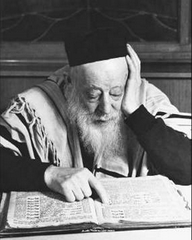
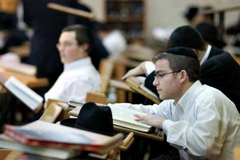 [slide_14] In the Yeshiva, they take Torah
study (the first 5 books of the Bible), study of Talumud (the long tradition of
interpretation that goes back over 2000 years), Jewish philosophy and Jewish
cultural thought. They generally keep up a full time course of study like this
until they are in their 30's and do not have time to work which is why these
communities are poor. [slide_15]
The women are the principal breadwinners and they also have families that
average 6 children.
[slide_14] In the Yeshiva, they take Torah
study (the first 5 books of the Bible), study of Talumud (the long tradition of
interpretation that goes back over 2000 years), Jewish philosophy and Jewish
cultural thought. They generally keep up a full time course of study like this
until they are in their 30's and do not have time to work which is why these
communities are poor. [slide_15]
The women are the principal breadwinners and they also have families that
average 6 children.
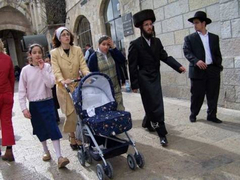 Some of these students are very, very bright. But they are
not educated in the Western sense of that word. They don't take liberal arts
courses, science, business, political thought. [slide_16] But they are deeply immersed in
Medieval thought forms that guided the great scholars like Maimonides who lived
in the 13th century. So they often have this really admirable
ability to memorize large tracts of text and they can quote Rabbinical thinkers
from 150 b.c. in the original tongue and translate it for you. But they have a
way of speaking about these long dead scholars like they are just recently
deceased and they are only interested in engaging the modern world that is [slide_17]
all around
Some of these students are very, very bright. But they are
not educated in the Western sense of that word. They don't take liberal arts
courses, science, business, political thought. [slide_16] But they are deeply immersed in
Medieval thought forms that guided the great scholars like Maimonides who lived
in the 13th century. So they often have this really admirable
ability to memorize large tracts of text and they can quote Rabbinical thinkers
from 150 b.c. in the original tongue and translate it for you. But they have a
way of speaking about these long dead scholars like they are just recently
deceased and they are only interested in engaging the modern world that is [slide_17]
all around
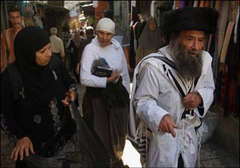 them to the extent that it is required for them to negotiate a place for their
community to live it's internal life which is their principal spiritual
imperative.
them to the extent that it is required for them to negotiate a place for their
community to live it's internal life which is their principal spiritual
imperative.
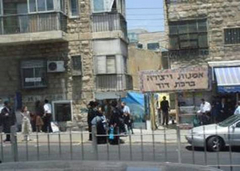 Jerusalem is much fuller of the Orthodox today
than it was 30 years ago, and more so then than at the founding of the state in
1948. [slide_18] Because
of that, I noticed this time, as a minority goyim, the way that the
ultra-Orthodox have a way of looking past you, not making eye contact. Part of
this, obviously, is that Jerusalem
is a big city and people don't make eye contact as much in big cities. But also
have a spiritual disposition that filters and segregates between the inner
community and everyone else. And they are relatively comfortable talking about
this. Certainly it is not the first thing that comes up in conversation, but if
you ask them about the future they envision were a two state solution to be
developed, they will tell you that they are not interested in living with Arabs
in the Sesame Street sense of a multi-cultural block of integrated people from
various backgrounds held together by a mutual respect and interest in
intermingling with one another. It is more of a détente, a respect where you
and your people are free and safe to develop your neighborhood over there as
long as you let us live free and safe over here and we only occasionally
interact at all.
Jerusalem is much fuller of the Orthodox today
than it was 30 years ago, and more so then than at the founding of the state in
1948. [slide_18] Because
of that, I noticed this time, as a minority goyim, the way that the
ultra-Orthodox have a way of looking past you, not making eye contact. Part of
this, obviously, is that Jerusalem
is a big city and people don't make eye contact as much in big cities. But also
have a spiritual disposition that filters and segregates between the inner
community and everyone else. And they are relatively comfortable talking about
this. Certainly it is not the first thing that comes up in conversation, but if
you ask them about the future they envision were a two state solution to be
developed, they will tell you that they are not interested in living with Arabs
in the Sesame Street sense of a multi-cultural block of integrated people from
various backgrounds held together by a mutual respect and interest in
intermingling with one another. It is more of a détente, a respect where you
and your people are free and safe to develop your neighborhood over there as
long as you let us live free and safe over here and we only occasionally
interact at all.
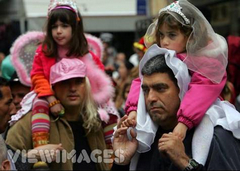 [slide_19] Now it is true that only 20% of
Israeli society is actually ultra-Orthodox. Something like 70% of Israeli
society doesn't really go to synagogue except for the High Holy Days or a Bar
Mitzvah. But there is a saying in Israel, you hear over and over and
over and it is this. “The Orthodox synagogue is the one I don't go to.” It is a very complex statement that partly
acknowledges that Orthodox Judaism is true strength Judaism, even if they can't
live it. Partly it acknowledges that you can get enough religious feeling just
living in a state that accommodates the Orthodox by having almost everything
stop on Sabbath, the High Holy Days, and every major hotel that keeps kosher,
etc.. And partly, it is also the fact
that there simply aren't very many Reformed or Conservative synagogues. In the U.S. probably
90% of the synagogues are Reformed or Conservative. In Israel,
probably 93% are Orthodox. It is a very different world.
[slide_19] Now it is true that only 20% of
Israeli society is actually ultra-Orthodox. Something like 70% of Israeli
society doesn't really go to synagogue except for the High Holy Days or a Bar
Mitzvah. But there is a saying in Israel, you hear over and over and
over and it is this. “The Orthodox synagogue is the one I don't go to.” It is a very complex statement that partly
acknowledges that Orthodox Judaism is true strength Judaism, even if they can't
live it. Partly it acknowledges that you can get enough religious feeling just
living in a state that accommodates the Orthodox by having almost everything
stop on Sabbath, the High Holy Days, and every major hotel that keeps kosher,
etc.. And partly, it is also the fact
that there simply aren't very many Reformed or Conservative synagogues. In the U.S. probably
90% of the synagogues are Reformed or Conservative. In Israel,
probably 93% are Orthodox. It is a very different world.
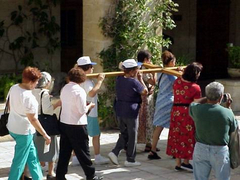
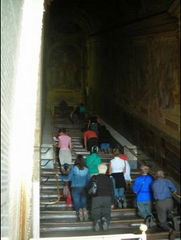 I can't explain all of the reasons
that this is the case but I would mention one really big one. The first one is
important for Christianity also. [slide_20] Israel
has been a land of pilgrimage for 2000 years for Christians and even longer for
Jews. Within 100 years after the time that Jesus died, Christians started
coming to the area to walk in his steps and infuse themselves with the ethos
that gave rise to his profound teaching. [slide_21] Jews also have returned periodically to
visit Jerusalem and other holy sites to Jews like the tomb of Jacob, to see the
place that Abraham first got a vision from God, or these days to see Masada,
where they held off the Romans until they were about to be overwhelmed and
chose death rather than slavery.
I can't explain all of the reasons
that this is the case but I would mention one really big one. The first one is
important for Christianity also. [slide_20] Israel
has been a land of pilgrimage for 2000 years for Christians and even longer for
Jews. Within 100 years after the time that Jesus died, Christians started
coming to the area to walk in his steps and infuse themselves with the ethos
that gave rise to his profound teaching. [slide_21] Jews also have returned periodically to
visit Jerusalem and other holy sites to Jews like the tomb of Jacob, to see the
place that Abraham first got a vision from God, or these days to see Masada,
where they held off the Romans until they were about to be overwhelmed and
chose death rather than slavery.
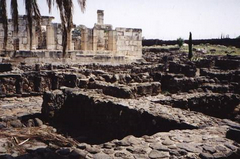
 [slide_22] Pilgrims want to get back to the
original source. They want to see the real deal. They want to see the genuine
edition before it got dumbed down, compromised, and acculturated. They want
ruins. They want artifacts. They want things ancient. The closer to the
original source, the more authentic and authoritative. [slide_23] And this pilgrimage mentality
permeates the whole area since thousands of them are wandering around the
country every day and really have been pretty much every day for the past 2000
years.
[slide_22] Pilgrims want to get back to the
original source. They want to see the real deal. They want to see the genuine
edition before it got dumbed down, compromised, and acculturated. They want
ruins. They want artifacts. They want things ancient. The closer to the
original source, the more authentic and authoritative. [slide_23] And this pilgrimage mentality
permeates the whole area since thousands of them are wandering around the
country every day and really have been pretty much every day for the past 2000
years.
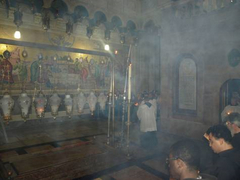
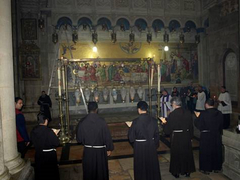 This ethos also shapes the spiritual
faith of the people that live in the region. Like all of the pilgrims around
them, they tend to look back to the source for inspiration and authority. This
is the root meaning of conservative, wanting to conserve the past tradition for
the future. [slide_24]
This ethos also shapes the spiritual
faith of the people that live in the region. Like all of the pilgrims around
them, they tend to look back to the source for inspiration and authority. This
is the root meaning of conservative, wanting to conserve the past tradition for
the future. [slide_24]
So this is what you see at the Church
of the Holy Sepuluchre in Jerusalem.
This is the Church that is built over the place where Jesus was buried. It is
right near one of the sights where the Romans used to crucify people, so there
is also an altar that remembers Calvary and a
place where pilgrims can kneel and kiss the ground for a blessing. [slide_25] And there is a
stone that commemorates the place that they laid the body of Jesus after he
died and where they anointed him for burial.
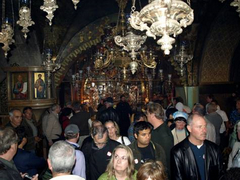
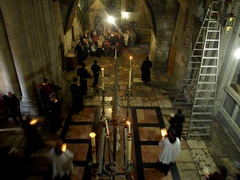 [slide_26] It is run by the Greek Orthodox
Church, the Armenian Orthodox Church and the Roman Catholic Church. They have
had monasteries here since the very beginning and have stayed throughout the
dismal centuries. Each of these groups trade off saying Mass. At this Church
and at the Church of the Nativity where Jesus was born in Bethlehem, there is pretty much a mass going
on all day long. [slide_27]
[slide_26] It is run by the Greek Orthodox
Church, the Armenian Orthodox Church and the Roman Catholic Church. They have
had monasteries here since the very beginning and have stayed throughout the
dismal centuries. Each of these groups trade off saying Mass. At this Church
and at the Church of the Nativity where Jesus was born in Bethlehem, there is pretty much a mass going
on all day long. [slide_27]
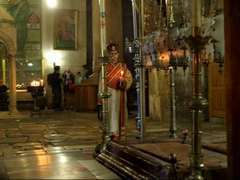
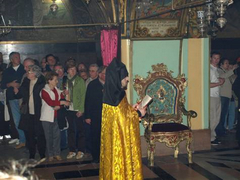 Only these don't have sermons because
they are more for the prayers that pilgrims can join in with. These churches
are old, built on ruins of other churches that were destroyed and rebuilt many
times during the Crusades. [slide_28]
Their liturgies are old too. The languages that they are spoken in no one any
longer understands: Russians use a Slavonic language from the 7th
century; Roman Catholics use Latin; The Greeks an ancient Greek that modern
people can no longer understand any more than our High School students can read
early English like ‘Beowoulf'. [slide_29] So it has a look and feel of performance art which
can be very off putting to people deeply immersed in modernity or it can be
appealing if you are looking for an earlier, more mystery-filled sense of
sacramental blessing.
Only these don't have sermons because
they are more for the prayers that pilgrims can join in with. These churches
are old, built on ruins of other churches that were destroyed and rebuilt many
times during the Crusades. [slide_28]
Their liturgies are old too. The languages that they are spoken in no one any
longer understands: Russians use a Slavonic language from the 7th
century; Roman Catholics use Latin; The Greeks an ancient Greek that modern
people can no longer understand any more than our High School students can read
early English like ‘Beowoulf'. [slide_29] So it has a look and feel of performance art which
can be very off putting to people deeply immersed in modernity or it can be
appealing if you are looking for an earlier, more mystery-filled sense of
sacramental blessing.
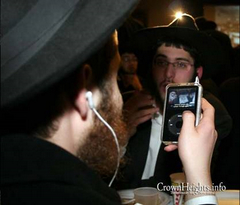
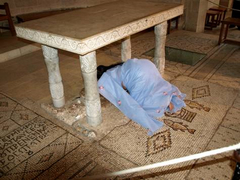 [slide_30] I might also add that pilgrims encourage this
as they come usually either looking for a personal sense of renewal and
conversion or bearing some particularly poignant prayer request. So with
regularity, you will see people prostrate in prayer or you will see someone
touching a scarf to the holy tomb, hoping that it's healing power will bless
someone back home in the Ukraine
when they return.
[slide_30] I might also add that pilgrims encourage this
as they come usually either looking for a personal sense of renewal and
conversion or bearing some particularly poignant prayer request. So with
regularity, you will see people prostrate in prayer or you will see someone
touching a scarf to the holy tomb, hoping that it's healing power will bless
someone back home in the Ukraine
when they return.
This is not the part of the Church
that is leading the charge to engage the Modern world in constructive dialogue.
In fact, they have a kind of schizophrenic relationship to the modern world. [slide_31] They want cell
phones, lap tops and ipods. But they do not want commercial advertizing that
promotes secular lifestyle. They live in a democratic society but they organize
themselves strictly segregated men from women, with men having almost all
important decision making, and they follow the lead of the religious leader.
(This last statement is simply true for every Orthodox group-Jew, Christian,
Muslim… They aren't congregational or democratic and view this arrangement as a
threat). They may take tithes from people that made that money in capitalist
enterprises but they themselves are aesthetics devoted to learning and liturgy.

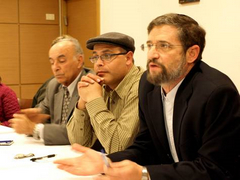 [slide_32] I was having a discussion with a
learned Palestinian Muslim who was explaining that we in the West need to be
patient with Muslims in the area because they have not yet had a Reformation
like we have had in the West and their faith needs to engage in that critical
self-reflection in order to have more constructive interfaith dialogue. He made
a very good point. I raised my hand for a comment. After acknowledging that
this is very important, and with all sincere respect, I pointed out that the
Reformation was 500 years ago. And we also had the Renaissance and we also went
through the Enlightenment that produced the secular world we co-inhabit today.
[slide_32] I was having a discussion with a
learned Palestinian Muslim who was explaining that we in the West need to be
patient with Muslims in the area because they have not yet had a Reformation
like we have had in the West and their faith needs to engage in that critical
self-reflection in order to have more constructive interfaith dialogue. He made
a very good point. I raised my hand for a comment. After acknowledging that
this is very important, and with all sincere respect, I pointed out that the
Reformation was 500 years ago. And we also had the Renaissance and we also went
through the Enlightenment that produced the secular world we co-inhabit today.
This is a big gap. [slide_33] I mention all
of this because it is important to understand that we don't just have 3
religions with competing truth claims that have to get along. In the Middle East, we are also talking about faith traditions
that are largely, if not exclusively, pre-modern in their orientation all
having to accommodate themselves to the modern world or not. And none of them
is motivated to engage the modern world, few of them see the need to really
take this discussion up with any substance.
 [slide_34] To date, the Interfaith Religious
Council in Israel
has been conducting extensive dialogues- exposing leaders from Islam, Judaism
and Christianity to each others faith traditions, their homes, their holiday
celebrations. They are doing very important trust-building work so that they
can be constructive in the midst of future crises. But to date, they have only
been able to agree on one item that I am aware of. Mutually, all of them
condemned a Gay pride march in Jerusalem
a couple years ago. The one dimension that they share in common is they view
these modern movements- like gays out of the closet- as a threat spiritually
and culturally. They have substantive friction with the modern world.
[slide_34] To date, the Interfaith Religious
Council in Israel
has been conducting extensive dialogues- exposing leaders from Islam, Judaism
and Christianity to each others faith traditions, their homes, their holiday
celebrations. They are doing very important trust-building work so that they
can be constructive in the midst of future crises. But to date, they have only
been able to agree on one item that I am aware of. Mutually, all of them
condemned a Gay pride march in Jerusalem
a couple years ago. The one dimension that they share in common is they view
these modern movements- like gays out of the closet- as a threat spiritually
and culturally. They have substantive friction with the modern world.
Can the Orthodox be a force for
reconciliation? Can they lead in forgiveness, repentance and peace? Perhaps,
but we also need to be realistic, even within the Christian tradition, we've
always been better at the work of forgiveness and reconciliation within our
small group than we have more broadly with other Christian traditions.
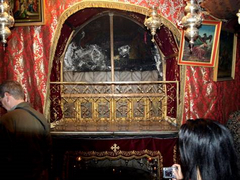
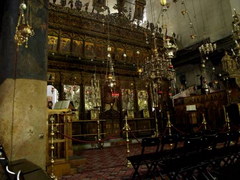 [slide_35] And you can see this right in the
Church of the Nativity in Bethlehem,
where Jesus was reportedly born. This Church is also administered by the three
traditions: The Greek Orthodox, the Armenian Orthodox, and the Roman Catholics.
These are three of our oldest Churches, each of them tracing themselves right
back to the first century in terms of apostolic succession [slide_36] (they can name
their bishops going right back to the beginning practically) and liturgy.
[slide_35] And you can see this right in the
Church of the Nativity in Bethlehem,
where Jesus was reportedly born. This Church is also administered by the three
traditions: The Greek Orthodox, the Armenian Orthodox, and the Roman Catholics.
These are three of our oldest Churches, each of them tracing themselves right
back to the first century in terms of apostolic succession [slide_36] (they can name
their bishops going right back to the beginning practically) and liturgy.
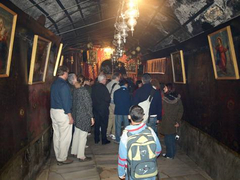
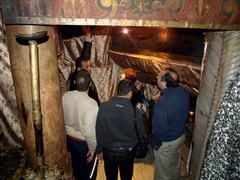 [slide_37] We happened to be there early in the morning before the
madding crowd. At the Church, you walk down under the chancel, down 6 steps to
the crèche, the stone room where Jesus was reportedly born in a stone stable.
Again, there is pretty much a continuous Mass going on throughout the day,
first Roman Catholic, then Greek Orthodox, then Armenian Orthodox. The day we
were there, we had to wait because the cleaning of the steps hadn't been done
and it has to follow a particular order. [slide_38] The top couple steps are cleaned by the
Roman Catholics, the middle couple are cleaned by the Greek Orthodox and the
bottom couple by the Armenian Orthodox. By the way, they get very grumpy with
each other and with you if you don't appreciate this arrangement.
[slide_37] We happened to be there early in the morning before the
madding crowd. At the Church, you walk down under the chancel, down 6 steps to
the crèche, the stone room where Jesus was reportedly born in a stone stable.
Again, there is pretty much a continuous Mass going on throughout the day,
first Roman Catholic, then Greek Orthodox, then Armenian Orthodox. The day we
were there, we had to wait because the cleaning of the steps hadn't been done
and it has to follow a particular order. [slide_38] The top couple steps are cleaned by the
Roman Catholics, the middle couple are cleaned by the Greek Orthodox and the
bottom couple by the Armenian Orthodox. By the way, they get very grumpy with
each other and with you if you don't appreciate this arrangement.
If we were to grade these people on
Kindergarten report cards: in that section that says ‘shares toys with others
and co-operates at play-time', we would have to mark the slot that reads, ‘needs
improvement'.
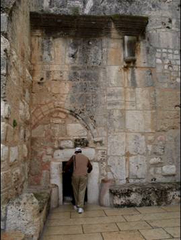
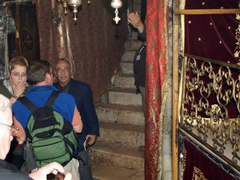 But these are not just churches, they
are also faith traditions that represent nations. And these nations have come
to blows in the past over these Holy
sites. [slide_39]
Actually, in the late 1850's there was a substantial fight over who controlled
the keys to the front door of this church- the Greek Orthodox Church had
control over the keys and the Roman Catholic Church wanted control. Eventually, the Russians got
involved on behalf of the Greek Church and the French got involved on behalf of
the Roman Church, the British got
dragged in, [slide_40]
the Ottomans also as they represented the Muslims that also make pilgrimage to
this church, then the British and it led to the Crimean War. Now wars are
fought over many deep, complex things but control of the Holy sites was right
up there among the most important reasons.
But these are not just churches, they
are also faith traditions that represent nations. And these nations have come
to blows in the past over these Holy
sites. [slide_39]
Actually, in the late 1850's there was a substantial fight over who controlled
the keys to the front door of this church- the Greek Orthodox Church had
control over the keys and the Roman Catholic Church wanted control. Eventually, the Russians got
involved on behalf of the Greek Church and the French got involved on behalf of
the Roman Church, the British got
dragged in, [slide_40]
the Ottomans also as they represented the Muslims that also make pilgrimage to
this church, then the British and it led to the Crimean War. Now wars are
fought over many deep, complex things but control of the Holy sites was right
up there among the most important reasons.
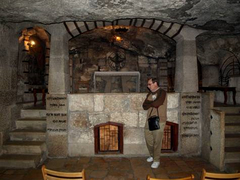 [slide_41] I'm standing there watching this
Aremenian monk wait irritably for the Romans to be finished with their chores
and I'm thinking that all of the national tensions and the world frictions are
just concentrated down right here on
these few steps… leading… of all places to the birthplace of Jesus who taught
us that the life of reconciliation, compassion, understanding and peace is more
important than religious purity and rectitude. There you have it.
[slide_41] I'm standing there watching this
Aremenian monk wait irritably for the Romans to be finished with their chores
and I'm thinking that all of the national tensions and the world frictions are
just concentrated down right here on
these few steps… leading… of all places to the birthplace of Jesus who taught
us that the life of reconciliation, compassion, understanding and peace is more
important than religious purity and rectitude. There you have it.
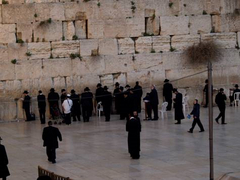
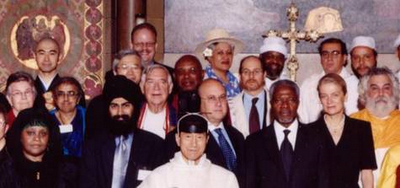 [slide_42] Religion has not been a major force
for reconciliation in the past. Or at least put it like this, religious people
have the same issues of control that seem to plague everyone else. And more
than that, there are some powerful impulses within their communities, as they
operate in pre-modern ways that promote a certain insularity and purity rather
than inclusivity and compromise. We need to be realistic about this, even if we
don't condone it. [slide_43]
[slide_42] Religion has not been a major force
for reconciliation in the past. Or at least put it like this, religious people
have the same issues of control that seem to plague everyone else. And more
than that, there are some powerful impulses within their communities, as they
operate in pre-modern ways that promote a certain insularity and purity rather
than inclusivity and compromise. We need to be realistic about this, even if we
don't condone it. [slide_43]
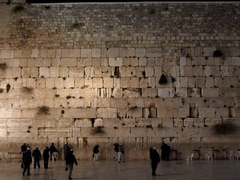 But, if you think you can go around
these people or you can just ignore them and create a political solution
without asking them to participate and work it through, [slide_44] you would also be hopelessly
naïve. I give great credit to those that are supporting interfaith dialogue,
difficult as it is. Profound reconciliation is not easy, quick work.
But, if you think you can go around
these people or you can just ignore them and create a political solution
without asking them to participate and work it through, [slide_44] you would also be hopelessly
naïve. I give great credit to those that are supporting interfaith dialogue,
difficult as it is. Profound reconciliation is not easy, quick work.
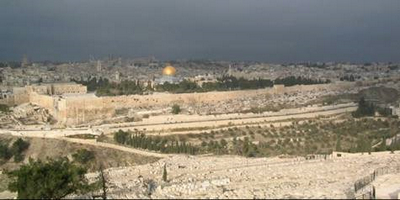 [slide_45] But it is absolutely necessary to break the
impasse. Something has to be done to stop the swirling vortex of revenge that
sucks us all down into ever deepening violence and ill will. This swirling
vortex is moving apace and getting more extreme.
[slide_45] But it is absolutely necessary to break the
impasse. Something has to be done to stop the swirling vortex of revenge that
sucks us all down into ever deepening violence and ill will. This swirling
vortex is moving apace and getting more extreme.
Meanwhile, the pace of change within
the Orthodox community is very slow and subtle. I asked one Ultra-Orthodox
Rabbi to comment on change within his community in the midst of the modern
world. He said, ‘You know, it is like having an antique wardrobe in your attic.
If you want to move it, you can't just push it across the floor or you will
break it and what is the point of that. Gently and with a lot of support, you
have to slowly move it little by little.' It is a good point.
But the modern challenges move with
increasing speed like new advances in technology. It is just hard to see how we
are going to have enough time to wait, even if we have no choice.

© 2008
Charles Rush.
All rights reserved.